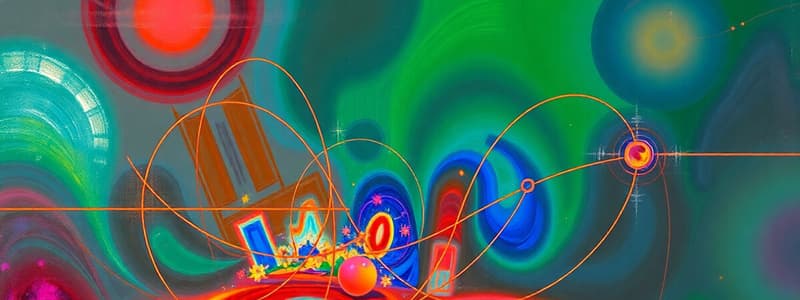Podcast
Questions and Answers
What is true about work done when moving a test charge along an equipotential surface?
What is true about work done when moving a test charge along an equipotential surface?
- Work done depends on the electric intensity.
- Work done is always zero (correct)
- Work done is equal to the potential difference between two points.
- Work done is constant regardless of the distance.
What describes the relationship between the electric field and equipotential surfaces?
What describes the relationship between the electric field and equipotential surfaces?
- Electric field lines run parallel to equipotential surfaces.
- Electric fields can be at an angle to equipotential surfaces.
- Electric field lines never intersect equipotential surfaces.
- Electric field is always normal to equipotential surfaces. (correct)
How are dielectrics classified?
How are dielectrics classified?
- Based on their thermal conductivity.
- Based on their molecular structure and charge distribution. (correct)
- Based on their ability to conduct electricity.
- Based on their color and appearance.
Which of the following is a characteristic of polar dielectrics?
Which of the following is a characteristic of polar dielectrics?
What is a common example of a non-polar dielectric?
What is a common example of a non-polar dielectric?
Which statement is true regarding the dipole moment of polar molecules?
Which statement is true regarding the dipole moment of polar molecules?
What happens to the charges in a dielectric material when placed in an external electric field?
What happens to the charges in a dielectric material when placed in an external electric field?
Why is work done to move a test charge in a non-equipotential surface?
Why is work done to move a test charge in a non-equipotential surface?
What is the expression for electric potential at point C due to a dipole?
What is the expression for electric potential at point C due to a dipole?
What is the electric potential at a point located on the equatorial line of a dipole?
What is the electric potential at a point located on the equatorial line of a dipole?
Which equation represents the potential due to a system of charges?
Which equation represents the potential due to a system of charges?
What is the significance of an equipotential surface?
What is the significance of an equipotential surface?
When calculating the potential at point P due to multiple charges, which theorem is applied?
When calculating the potential at point P due to multiple charges, which theorem is applied?
For a point lying on the axis of a dipole, what is the potential expressed as?
For a point lying on the axis of a dipole, what is the potential expressed as?
Which value of theta corresponds to zero potential at the equator of a dipole?
Which value of theta corresponds to zero potential at the equator of a dipole?
How is an equipotential plane defined?
How is an equipotential plane defined?
What is the formula for equivalent capacitance of n condensers connected in parallel?
What is the formula for equivalent capacitance of n condensers connected in parallel?
What is the expression for the capacitance of a parallel plate capacitor without a dielectric?
What is the expression for the capacitance of a parallel plate capacitor without a dielectric?
In a capacitor, what happens to the electric field between the plates when a dielectric slab is introduced?
In a capacitor, what happens to the electric field between the plates when a dielectric slab is introduced?
How is the total charge defined in a system with three capacitors in parallel?
How is the total charge defined in a system with three capacitors in parallel?
What does the symbol σ represent in the context of capacitance?
What does the symbol σ represent in the context of capacitance?
What is the relationship between charge (q), capacitance (C), and potential difference (V) for a capacitor?
What is the relationship between charge (q), capacitance (C), and potential difference (V) for a capacitor?
What effect does inserting a dielectric material in a capacitor have on its capacitance?
What effect does inserting a dielectric material in a capacitor have on its capacitance?
What happens to the electric field outside the plates of a parallel plate capacitor?
What happens to the electric field outside the plates of a parallel plate capacitor?
What is the relationship between electric field and potential gradient?
What is the relationship between electric field and potential gradient?
Where is the zero potential typically set for a point charge?
Where is the zero potential typically set for a point charge?
What is the electric potential at a distance r from a point charge q?
What is the electric potential at a distance r from a point charge q?
What is true about electric potential due to a positively charged particle?
What is true about electric potential due to a positively charged particle?
What is the electric intensity E due to a point charge q at distance r?
What is the electric intensity E due to a point charge q at distance r?
How does the electric potential behave as the distance from a point charge approaches infinity?
How does the electric potential behave as the distance from a point charge approaches infinity?
What defines an electric dipole?
What defines an electric dipole?
What is the general nature of electric potential due to a single point charge?
What is the general nature of electric potential due to a single point charge?
What is the relationship between the induced field Ep and the external field E0 in a dielectric?
What is the relationship between the induced field Ep and the external field E0 in a dielectric?
How does the capacitance change if the dielectric fills the entire capacitor?
How does the capacitance change if the dielectric fills the entire capacitor?
In the context of a capacitor, what does the symbol K represent?
In the context of a capacitor, what does the symbol K represent?
What happens to the electric field across a capacitor when a dielectric is introduced?
What happens to the electric field across a capacitor when a dielectric is introduced?
What is the formula for the capacitance of a capacitor filled with n dielectric slabs?
What is the formula for the capacitance of a capacitor filled with n dielectric slabs?
What is the effect of introducing a conducting slab into a capacitor with dielectric?
What is the effect of introducing a conducting slab into a capacitor with dielectric?
If the dielectric constant (K) is 1, what does that imply about the material?
If the dielectric constant (K) is 1, what does that imply about the material?
What does the equation C = (Aε0)/(d-t + t/k) represent?
What does the equation C = (Aε0)/(d-t + t/k) represent?
Study Notes
Equipotential Surfaces
- Equipotential surfaces are surfaces where the electric potential is the same at every point.
- For a single point charge, equipotential surfaces are concentric spheres centered at the charge.
- No work is required to move a test charge along an equipotential surface.
- The electric field is always perpendicular to the equipotential surface.
Dielectrics and Electric Polarization
- Dielectrics are insulators that can store electrical energy.
- When placed in an external electric field, dielectrics polarize, meaning their positive and negative charges are displaced in opposite directions.
- This displacement creates a net dipole moment in the molecules of the dielectric.
- Examples of dielectrics include glass, wax, mica, and rubber.
Polar Dielectrics
- Polar molecules have a permanent electric dipole moment due to the center of gravity of positive nuclei and revolving electrons not coinciding.
- Examples include HCl, H2O, and N2O.
- These molecules have asymmetric shapes.
Non-polar Dielectrics
- Non-polar molecules have a center of gravity of positive nuclei and revolving electrons that coincide.
- Examples include H2, O2, CO2, and polythene.
- These molecules have symmetric shapes.
Electric Field and Potential Gradient
- The electric field at a point is the negative of the potential gradient at that point.
- This means the electric field is the rate of change of electric potential with respect to distance.
Zero Potential
- The zero point of electric potential is arbitrary.
- For a point charge, the zero potential is usually set at infinity.
- For electrical circuits, the Earth is often considered to be at zero potential.
Electric Potential Due to a Point Charge
- The electric potential at a point A due to a point charge +q is the work done per unit positive charge when it is moved from infinity to point A.
- This potential is given by V = q/4πε0r, where r is the distance from the charge to point A.
- A positively charged particle produces a positive electric potential, while a negatively charged particle produces a negative electric potential.
- The electric potential due to a single charge is spherically symmetric, meaning it is the same in all directions at a given distance.
Electric Potential Due to an Electric Dipole
- An electric dipole consists of two equal and opposite charges separated by a finite distance.
- The electric potential at a point C due to an electric dipole is given by Vc= (q2l cosθ)/4πε0r2, where q is the magnitude of each charge, 2l is the distance between the charges, θ is the angle between the dipole axis and the position vector of point C, and r is the distance from the center of the dipole to point C.
Electric Potential Due to a System of Charges
- The electric potential at a point P due to a system of n charges q1, q2, ..., qn located at distances r1, r2, ..., rn from P is given by V = 1/4πε0 ∑i=1n qi/ri.
Capacitance
- Capacitance is a measure of a capacitor's ability to store an electric charge.
- It is defined as the ratio of the charge stored on a capacitor to the potential difference across it.
- Capacitance is measured in Farads (F).
- For a parallel plate capacitor filled with a dielectric, the capacitance is given by C = (Aε0K)/d, where A is the area of each plate, d is the distance between the plates, ε0 is the permittivity of free space, and K is the dielectric constant.
Capacitance of Parallel Plate Capacitor
- A parallel plate capacitor consists of two parallel conductive plates separated by a distance.
- The capacitance without a dielectric is C = (Aε0)/d.
- This means the capacitance is directly proportional to the area of the plates and inversely proportional to the distance between them.
- When a dielectric material is inserted between the plates, the capacitance increases by a factor of K, the dielectric constant.
Displacement Current
- In a capacitor with a dielectric, current flows through the conducting wires but not between the plates.
- This is because there are no free electrons available for conduction in the dielectric.
- However, a displacement current exists between the capacitor plates due to the changing electric field.
- Displacement current is a consequence of the changing electric flux through the dielectric.
Studying That Suits You
Use AI to generate personalized quizzes and flashcards to suit your learning preferences.
Related Documents
Description
Test your understanding of equipotential surfaces and dielectrics with this quiz. Explore concepts such as electric potential, polarization in dielectrics, and the characteristics of polar molecules. Ideal for students of physics and electrical engineering.




